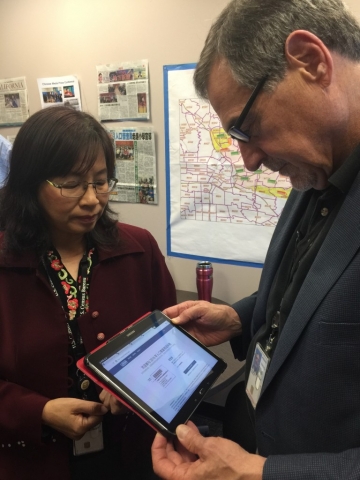May242016
Posted at 11:04 AM
Post by John Thompson
Following is a cross-post from the U.S. Census Bureau Director's Blog
This week I am visiting Los Angeles County to observe the last phase of the 2016 Census Test, currently underway here in California as well as in Harris County, Texas. Almost 225,000 households in Los Angeles County received a notification from the U.S. Census Bureau by mail 9 weeks ago asking them to complete the 2016 Census Test questionnaire online. Now, census takers are engaged in what we call “nonresponse follow-up” — that is, personally visiting households that did not respond to the census.
Using technology to refine our nonresponse follow-op operations is a critical part of our preparations for the 2020 Census. The testing that’s underway in California and Texas will help us hone the innovative, cost-saving procedures outlined in the 2020 Census Operational Plan.
In the current phase of the 2016 Census Test, we’re refining the technologies and methods that we use to assign cases to field staff conducting nonresponse follow-up visits. In 2020, we plan to automate much of the door-to-door field work involved in this operation and better manage census takers’ workloads and routing in real time.
We’re also continuing to refine our innovative use of mobile technology in our follow-up efforts. We’re replacing paper and pencil with mobile devices for census takers who visit nonresponding households. These devices have special software that census takers will use to securely collect households’ information and transmit that data, daily assignments, updates and timesheets.
Finally, we’re continuing our research into how to best use existing government and commercial information to reduce the nonresponse follow-up workload. For example, we’re exploring how to use records to identify vacant units that we don’t need to visit. We’re also working on ways we can use this information to reduce the number of visits census takers make to nonresponding households, and to count those households if they don’t respond after multiple visits.
Through the smart use of technology and innovations like these, we can save up to $5.2 billion, compared to repeating the design of the 2010 Census. Thank you to the residents of Los Angeles County and Harris County for participating in this critical census test. Your cooperation is critical to helping us design a complete and accurate census in 2020, one that will give America the data it needs to make good policies and decisions for its growing population.
You can track the results of the 2016 Census Test and our plans for the 2020 Census at www.census.gov/2020census


